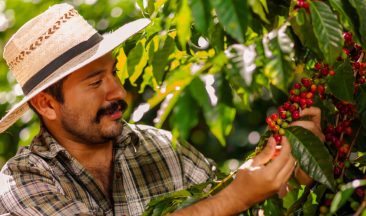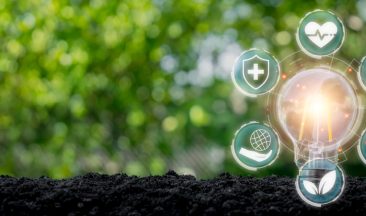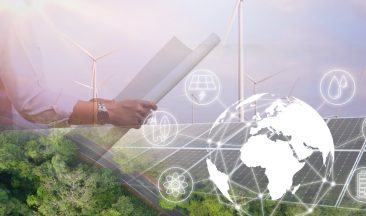Novel technologies in agriculture are reshaping traditional practices and ushering in a new era of efficiency and sustainability. The agricultural sector is under immense pressure to transition due to rising input and labor costs, which are putting farm profits at risk. Globally, the prices of inputs such as fertilizers and crop protection products have risen by 80 to 250% over the past few years.
Climate change is also squeezing profits and farming needs to become more climate resilient. Challenging climate changes are resulting in increased weather variability, more frequent extreme weather events, such as flooding, longer droughts, and new invasive crops and pests, all of which reduce yields.
For example, in the American Southwest, an ongoing drought has been so severe that the past two decades have been the region’s driest in at least 1,200 years, with record-breaking heat in the southern United States over last year’s summer.
To navigate these challenges and remain economically viable, farmers must find innovative solutions and AgTech has great potential in achieving this.
Historical Overview of Agricultural Technology
The history of agricultural technology is marked by pivotal revolutions that transformed farming practices. The “fourth agricultural revolution” or “agriculture 4.0” has already begun. Each previous agricultural revolution was radical at the time. The first revolution was the transition from hunting and gathering to settled agriculture.
The second relates to the agricultural revolution in the 18th century which saw a transition to commercial farming. The third revolution relates to post-war productivity increases associated with mechanization and the Green Revolution in the developing world. Each era brought significant advances in technology.
The transition from traditional to modern methods paved the way for increased productivity and scalability. In the modern agricultural world, Israel revolutionized agriculture by inventing drip irrigation. This was only the beginning of the AgTech revolution.
What New Methods and Technologies are Revolutionizing Agriculture?
Agriculture 4.0 is revolutionizing modern farming. The ongoing advancements in agricultural technology have ushered in this new era, characterized by the integration of digital technologies, Artificial Intelligence, and innovative solutions that are transforming the way farming is conducted.
The fusion of these cutting-edge tools is not only enhancing productivity but also promoting sustainability and efficiency across the agricultural sector. As we navigate through this transformation, several key areas stand out as pivotal in driving the future of agriculture.
Key areas of Agriculture 4.0 include increased automation and robotics, Artificial Intelligence, precision farming, genomics and gene editing, and the use of online banking, trading, and blockchain technology throughout supply chains.
Comprehensive Look at Current Emerging Agriculture Technologies
Today’s agriculture is a tapestry woven with cutting-edge technologies. From data-driven decision-making to the use of biotechnology, farmers are equipped with a diverse set of tools. The benefits are manifold, including increased yields, resource efficiency, and the ability to tackle challenges such as pests and diseases.
Future Trends and Emerging Technologies
Peering into the future, several trends and emerging technologies in agriculture are poised to shape the agricultural landscape with many of these already emerging. Alongside automation, predictive analytics, gene editing, and blockchain in supply chain management are among the developments that hold promise.
These trends are underpinned by digitization and big data analytics. Smart farming uses the Internet of Things (IoT) devices and sensors for data collection and analysis in agriculture. Connected sensors can monitor soil conditions, weather, and crop health in real time. IoT devices help farmers make more informed data-driven decisions, improving overall farm management and sustainability.
Additionally, AgTech Trends in 2024 emphasize the growing focus on sustainable practices and regenerative agriculture, driving innovation towards more resilient and eco-friendly farming systems. Exploring these emerging fields provides a glimpse into the potential impacts on efficiency, sustainability, and global food security.

Embracing Climate Smart Agriculture Technologies
Climate-smart agriculture technologies play a crucial role in building resilience against the impacts of climate change and in maintaining and building food security. Innovations in water conservation and climate-resilient crops are becoming essential components of modern farming. These technologies not only mitigate environmental risks but also contribute to the long-term sustainability of agriculture.
Farmers are now adopting a more judicious use of fertilizers, combining traditional fertilizers with advanced alternatives and biostimulants. This integrated approach optimizes crop health and productivity while enhancing soil health and promoting sustainable practices, leading to more resilient and eco-friendly farming systems.
Key Climate-Smart Agriculture Technologies
- Precision Agriculture Technologies:
Precision agriculture technologies emphasize the importance of targeted optimized and uniquely adjusted farming practices for each individual farm. By leveraging technologies such as GPS-guided tractors and sensor-equipped machinery, farmers can precisely manage resources like water and fertilizers. The result is increased efficiency, reduced environmental impact, and improved yields. - Water Saving Technologies:
Water is becoming a critical issue within agriculture due to climate change driving increased interest in water-saving technologies. Efficient water management is essential for sustainable farming, especially in the face of climate change. Adopting these technologies helps farmers use water resources more effectively, ensuring that crops receive adequate hydration without wastage.- Drip Irrigation Systems: Provide water directly to plant roots, reducing water waste and improving efficiency. This method significantly lowers water consumption compared to traditional irrigation methods, ensuring crops get the exact amount of water they need
- Rainwater Harvesting: Captures and stores rainwater for irrigation, reducing dependency on groundwater. It helps conserve water resources and provides a reliable water supply during dry periods.
- Smart Irrigation Systems: Use sensors and IoT to monitor soil moisture levels and automate irrigation schedules for optimal water use. These systems ensure that crops receive the right amount of water at the right time, ensuring optimal water use and savings.
- Soil Surfactants: Soil surfactants help make the most of irrigation water by reducing water’s surface tension, and improving its ability to move vertically and laterally. Products like H2Flo® liquid surfactant enhance soil penetration, reduce runoff, and prevent water-repellent deposits from hardening, leading to water savings of up to 25% in trials.
- Climate-Resilient Crop Varieties:
The development and use of crop varieties that are tolerant to drought, heat, cold, salinity, and pests ensure high yields under stress conditions. These crops can maintain food production levels despite adverse climate conditions, helping to secure food supply.
Advances in DNA sequencing platforms and high throughput phenotyping have revolutionized crop breeding and research and this, in combination with AI analyses, is speeding up the development of new resilient and productive crop varieties. For example, CRISPR technology enables precise gene editing for pest resistance, drought tolerance, and improved nutritional content. - Artificial Intelligence (AI)
AI is using computer systems to perform tasks that typically require human intelligence. AI is used in agriculture for predictive analytics, crop monitoring, and decision support systems. Machine learning algorithms can analyze large datasets to provide insights into optimal farming practices and allow farmers and growers to make more efficient use of scarce resources.
AI helps predict weather patterns, crop yields, and pest outbreaks, enabling farmers to make informed decisions. It also supports precision farming by recommending the optimal use of inputs like water, fertilizers, and pesticides, thereby enhancing efficiency and sustainability. In addition, AI is often used to invent new agricultural inputs for plant protection and/or nutrition. - Genomics and Gene Editing
Advances in DNA sequencing and gene editing technologies, such as CRISPR, are creating more resilient and productive crop varieties and allow for “greener” Ag inputs. These technologies enable precise modifications at the genetic level, leading to crops that are better adapted to changing climate conditions and resistant to pests and diseases. Genomics and gene editing also facilitate the development of crops with enhanced nutritional content, improving food quality and security. By accelerating the breeding process and enabling the creation of superior crop varieties, these innovations are key components of climate-smart agriculture. - Integrated Pest Management (IPM)
Combines biological, physical, and chemical tools to manage pests in an environmentally and economically sustainable way. IPM reduces reliance on chemical pesticides, lowering the risk of pest resistance and minimizing environmental contamination. - Soil Health
Maintaining and enhancing soil health is crucial for sustainable agriculture, as healthy soils support robust plant growth and resilience. Soil health technologies focus on improving soil structure, fertility, and microbial activity to create a thriving environment for crops. These technologies ensure that soils remain productive and resilient against environmental stresses. - Renewable Energy
Renewable energy technologies utilize solar, wind, and bioenergy to power farm operations, reducing reliance on fossil fuels and lowering greenhouse gas emissions. These systems can provide cost savings and increase energy security for farms, promoting sustainable agricultural practices. - Digital Agriculture
Digital agriculture leverages mobile apps, cloud computing, and digital tools to provide real-time information on weather forecasts, market prices, and best farming practices. This facilitates better decision-making and improves overall farm management efficiency. Digital agriculture aims to provide farmers with actionable data to make informed decisions, optimize resource use, and improve crop yields. - Automation and Robotics
Automation technologies include the use of drones, autonomous machinery, and robots to perform various agricultural tasks. Automation has great potential to streamline tasks on farms and enhance precision, increase efficiency, reduce labor costs, and minimize human error, leading to more sustainable farming practices. By optimizing resource use and reducing waste, automation supports the goals of climate-smart agriculture.
However, it is still in its early days. McKinsey’s 2022 Farmers Global Insights Survey reveals that less than 5% of farmers across Asia, Europe, North America, and South America are using this next-generation technology, compared with 21% using farm management software. - Integrated Nutrient Management:
Integrated nutrient management combines the use of fertilizers to optimize nutrient availability, improve soil health, and minimize environmental impact. This balanced approach ensures sustainable nutrient management and enhances crop productivity.
Advanced nutrient management practices include soil testing, precision application of nutrients, and the use of biostimulants to enhance nutrient use efficiency and promote healthier plant growth.
Biostimulants vitalize soil activity, resulting in improved nutrient uptake and productivity as well as increased tolerance and recovery from stresses such as heat, water, or disease. ICL biostimulants offer numerous benefits for various applications, including enhancing crop yields, improving soil health, increasing stress tolerance, and supporting healthy, resilient plants. - Carbon Sequestration Practices:
Carbon sequestration practices such as reforestation, afforestation, and soil carbon sequestration help absorb carbon dioxide from the atmosphere and store it in plants and soils. These practices contribute to mitigating climate change and improving ecosystem health.
ICL: A Leader in AgTech
ICL stands out as a key player within AgTech, driving innovation and advanced technologies in agriculture. ICL has established the Planet Startup Hub, their corporate investment arm, which functions both as an innovation Food Tech and AgTech hub and invests in energy storage, new materials, and other fields. This way, ICL connects its knowledge, experience, strengths, and resources with external collaborators to foster innovation.
With over a 100-year history and a steadfast commitment to addressing global agricultural challenges, ICL’s contributions are noteworthy. Our innovative digital solutions, including Agmatix, GROWERS, and ICLeaf, exemplify our dedication to providing farmers with cutting-edge tools for success.
Agmatix
Our agroinformatics company, Agmatix, transforms agronomic big data into actionable insights that enable agriculture professionals to optimize field trial research and crop nutrition.
ICLeaf
ICLeaf is an innovative technology that utilizes X-ray-based leaf nutrient analysis to provide precise and timely plant nutrition insights, helping agronomists and farmers optimize their crop nutrition plans. By leveraging this fast and cost-effective analysis, ICLeaf enhances data-driven decision-making, improving crop productivity and environmental sustainability.
GROWERS
Our digital platform, GROWERS, simplifies the process of finding, comparing, and purchasing agricultural products while enhancing operational efficiency and sustainability. By providing easy access to data and recommendations, GROWERS helps users manage their operations more efficiently, streamlining agricultural practices for better profitability and sustainability.
Additionally, our Planet Startup Hub portfolio includes a diverse group of visionary AgTech startups that are pioneering new solutions in agriculture. The following companies are part of our portfolio:
Agrematch
Agrematch is a pioneering data-science product discovery and development company providing novel bioactive compounds for industries needing new and improved products. Its unique artificial intelligence (AI) computational system identifies molecules with the desired compound-organism interaction, accelerating time to market and reducing R&D costs and risks.
Lavie Bio
Lavie Bio aims to improve food quality, sustainability, and agricultural productivity through microbiome-based ag-biological products. Utilizing a proprietary computational predictive platform, Lavie Bio discovers, optimizes, and develops bio-stimulant and bio-pesticide products.
CropX
CropX is an agricultural analytics company that addresses the need to grow more with less to feed the world’s rising population. By combining real-time soil data from proprietary sensors with above-ground data sets, CropX enhances the agricultural decision-making process, improving resource efficiency and crop yields.
Conclusion
Technology has become the cornerstone of a new agricultural era. The collective impact of industry leaders like ICL is shaping the future of farming, ensuring that agriculture remains not only productive but also sustainable. The integration of advanced technologies is not just a choice; it’s a necessity as we navigate the challenges of feeding a growing global population while preserving the planet for future generations.
Embracing innovations in AgTech enhances farm efficiency and productivity, while also building resilience against climate change. The future of agriculture relies on our ability to innovate and adapt. With ongoing advancements in AgTech, we are on the path to achieving a more sustainable and secure food supply for all.








